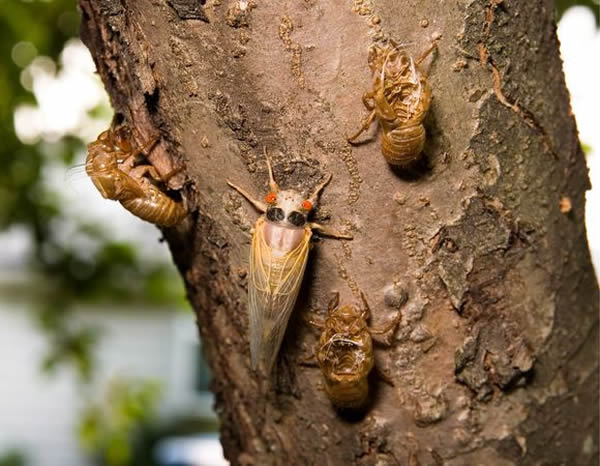Cicada DNA Helps Explain Strange Breeding Cycle
This spring will bring swarms of cicadas to the U.S. East Coast, from North Carolina up to Connecticut. Yet it has long been a puzzle how cicadas got stuck in 13- and 17-year life cycles.
Periodical cicadas spend most of their lives underground while surviving on bacteria and tree roots. When the ground thaws to 65°F (18°C) in the 13th or 17th year (depending on their species), they leave their homes to search for a mate.
Different broods of cicadas have different population sizes and different breeding schedules, but Brood 2, the population that will appear this month, is expected to fill the skies with millions of cicadas.
A 17-year Cicada climbs a tree past molted exoskeletons of other Cicadas as the brood emerges from the ground.
Some researchers think that cicadas developed their cycles through millennia of evolution. The ones that emerged on regular one- or two-year timelines were killed by waiting predators. The 13- and 17-year life cycles make it hard for predators to predict their emergence from underground nests.
A 2004 Brazilian study suggested that cicadas didn't just settle on a random number, but instead found that intervals based on prime numbers—integers divisible by only one and themselves (3, 5, 7, 11, 13, 17, etc.)—offered the best breeding strategy for staying alive.
Now, researchers in Japan and the U.S. reveal in a new study published in the Proceedings of the National Academies of Science that breeding on intermittent cycles has changed the insect's DNA over time. The study showed that cicadas of different species, despite the similar way they emerge on specific timelines, evolved independently over millions of years.
The findings came from analyzing DNA from 30 years of samples kept at the University of Connecticut. Researchers effectively charted cicada history by comparing nuances in DNA and doing geographic sampling of existing species. The overlap between results of both techniques revealed that at least three cicada species—the number researchers studied out of a possible seven—first diverged from each other 3.9 million years ago, according to co-author John Cooley.
"What this shows is there is genetic patterning among these species," says Cooley, an environmental scientist and cicada researcher at UConn. "There seems to be multiple evolutions of 13- and 17-year cicadas distinct from each other."
Even though it's in their genes, cicadas aren't bound to the number of years in their breeding cycle. Earlier research found that the insects can alternate between 13- and 17-year cycles. The usual cause of the switch may be dramatic changes in the Earth's climate that confused the cicadas' innate timekeeping mechanism.(Daniel Stone,National Geographic News,Published April 19, 2013)












